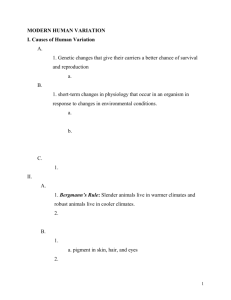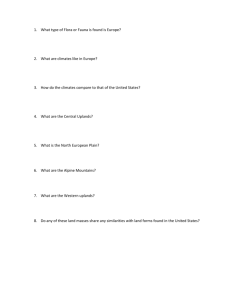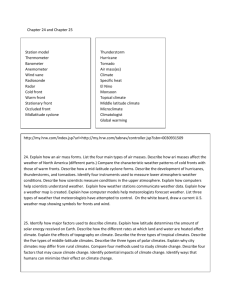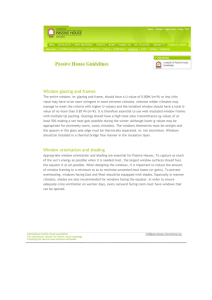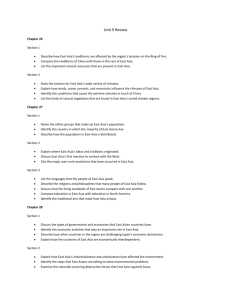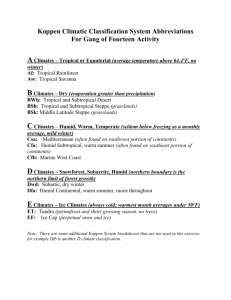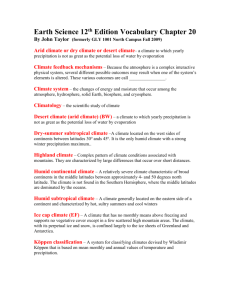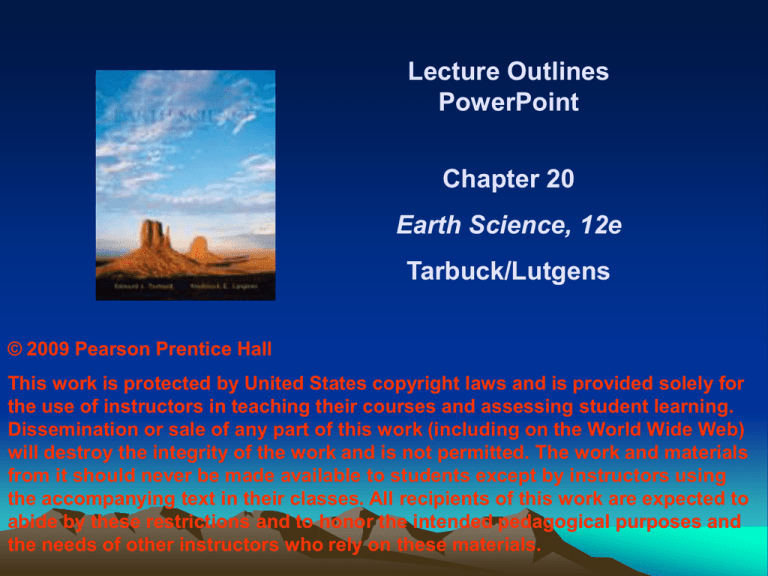
Lecture Outlines
PowerPoint
Chapter 20
Earth Science, 12e
Tarbuck/Lutgens
© 2009 Pearson Prentice Hall
This work is protected by United States copyright laws and is provided solely for
the use of instructors in teaching their courses and assessing student learning.
Dissemination or sale of any part of this work (including on the World Wide Web)
will destroy the integrity of the work and is not permitted. The work and materials
from it should never be made available to students except by instructors using
the accompanying text in their classes. All recipients of this work are expected to
abide by these restrictions and to honor the intended pedagogical purposes and
the needs of other instructors who rely on these materials.
Earth Science,
12e
World Climates and
Global Climate Change
Chapter 20
The climate system
Climate is an aggregate of weather
Involves the exchanges of energy and
moisture that occur among the
•
•
•
•
•
Atmosphere
Hydrosphere
Solid Earth
Biosphere, and
Cryosphere (ice and snow)
World climates
Every location has a distinctive climate
The most important elements in a
climatic description are
• Temperature, and
• Precipitation
Climate classification
Brings order to large quantities of
information
Many climatic-classification systems
have been devised
Köppen classification of climates
• Best known and most used system
• Uses mean monthly and annual values of
temperature and precipitation
Climate classification
Köppen classification of climates
• Divides the world into climatic regions in a
realistic way
• Boundaries Köppen chose were largely
based on the limits of certain plant
associations
• Five principal climate groups
• Humid tropical (A)
• Dry (B)
• Humid middle-latitude with mild winters (C)
Climate classification
Köppen classification of climates
• Five principal climate groups
• Humid middle-latitude with severe winters (D)
• Polar (E)
• A, C, D, and E climates are defined on the
basis of temperature characteristics
• Precipitation is the primary criterion for the
B group
Climates of
the world
based on the
Köppen
classification
Figure 20.4
Climates of
the world
based on the
Köppen
classification
(continued)
Figure 20.4
Köppen climates
Humid tropical (A) climates
• Winterless climates, with all months having
a mean temperature above 18ºC
• Two main types
• Wet tropics
• High temperatures and year-round rainfall
• Luxuriant vegetation (tropical rain forest)
• Discontinuous belt astride the equator
• Strongly influenced by the equatorial low
pressures
Köppen climates
Humid tropical (A) climates
• Two main types
• Tropical wet and dry
• Poleward of wet tropics and equatorward of
the tropical deserts
• Tropical grassland (savanna)
• Seasonal rainfall
Comparison of A-type
climates
Figure 20.6
Köppen climates
Dry (B) climates
• Evaporation exceeds precipitation and
there is a constant water deficiency
• Boundary determined by formulas involving
the three variables
• Average annual precipitation
• Average annual temperature
• Seasonal distribution of precipitation
Köppen climates
Dry (B) climates
• Two climatic types
• Arid or desert (BW)
• Semiarid or steppe (BS)
• More humid than arid climate
• Surrounds desert
• Causes of deserts and steppes
• In the low latitudes
• e.g., North Africa to northwestern India,
northern Mexico, southwestern U.S.
Arid and semiarid climates
of the world
Figure 20.8
Köppen climates
Dry (B) climates
• Causes of deserts and steppes
• In the low latitudes
• Coincide with the dry, stable, subsiding air
of the subtropical high-pressure belts
• Middle-latitude deserts and steppes
• Due to their position in the deep interiors of
large landmasses and/or the presence of
high mountains
• Most are located in the Northern
Hemisphere
Comparison of B-type
climates
Figure 20.9
Köppen climates
Humid middle-latitude climates with mild
winters (C climates)
• Average temperature of the coldest month
is below 18˚C but above –3˚C
• Subgroups
• Humid subtropics
• Eastern sides of continents
• 25 to 40 degrees latitude range
• Hot, sultry summers
• Mild winters
• Winter precipitation is generated along
fronts
Köppen climates
Humid middle-latitude climates with mild
winters (C climates)
• Subgroups
• Marine west coast
• Western (windward) side of continents
• 40 to 65 degrees north and south latitude
• Onshore flow of ocean air
• Mild winters and cool summers
Köppen climates
Humid middle-latitude climates with mild
winters (C climates)
• Subgroups
• Dry-summer subtropics
• West sides of continents between latitudes
30˚ and 45˚
• Strong winter rainfall maximum
• Often called a Mediterranean climate
Comparison of C-type
climates
Figure 20.10
Köppen climates
Humid middle-latitude climates with
severe winters (D climates)
• Average temperature of the coldest month
is below –3˚C and the warmest monthly
mean exceeds 10˚C
• Land-controlled climates
• Absent in the Southern Hemisphere
Köppen climates
Humid middle-latitude climates with
severe winters (D climates)
• Subgroups
• Humid continental
• Confined to the central and eastern portions
of North America and Eurasia between 40
and 50 degrees north latitude
• Severe winter and summer temperatures
• High annual temperature ranges
• Precipitation is generally greater in the
summer than in the winter
• Snow remains on the ground for extended
periods
Köppen climates
Humid middle-latitude climates with
severe winters (D climates)
• Subgroups
• Subarctic
• North of the humid continental climate
• Often referred to as the taiga climate
• Largest stretch of continuous forests on Earth
• Source regions of cP air masses
• Frigid winters, remarkably warm but short
summers
Comparison of D-type
climates
Figure 20.12
Köppen climates
Polar (E) climates
• Mean temperature of the warmest month is
below 10ºC
• Enduring cold
• Meager precipitation
• Two types of polar climates
• Tundra climate (ET)
• Treeless climate
• Almost exclusively in the Northern
Hemisphere
• Severe winters, cool summers
• High annual temperature range
Köppen climates
Polar (E) climates
• Two types of polar climates
• Ice cap climate (EF)
• No monthly mean above 0ºC
• Permanent ice and snow
Highland climates
• Usually cooler and wetter than adjacent
lowlands
• Great diversity of climatic conditions
• Best described by the terms variety and
changeability
Comparison of E-type
climates
Figure 20.15
Human impact on
global climate
Humans have been modifying the
environment over extensive areas for
thousands of years
• By using fire
• By overgrazing of marginal lands
Most hypotheses of climatic change are
to some degree controversial
Human impact on
global climate
Global warming
• Water vapor and carbon dioxide absorb
heat and are largely responsible for the
greenhouse effect of the atmosphere
• Burning fossil fuels has added great
quantities of carbon dioxide to the
atmosphere
Energy consumption in the
United States, 2004
Figure 20.17
Human impact on
global climate
The atmosphere response
• Global temperatures have increased
• Balance of evidence suggests a human
influence on global climate
• Globally averaged surface temperature is
projected to increase by 1.4 to 5.8ºC by the
year 2100
• The role of trace gases
• Atmospheric trace gases
• Methane
• Nitrous oxide
• Certain chlorofluorocarbons
Average global temperature
variations 1860–2006
Figure 20.20
Human impact on
global climate
The atmosphere’s response
• The role of trace gases
• Absorb wavelengths of outgoing Earth radiation
• Taken together, their warming effects may be
nearly as great as carbon dioxide
Climate-feedback
mechanisms
Possible outcomes of altering the
climate system
Two types
• Positive-feedback mechanisms reinforce
the initial change
• Negative-feedback mechanisms produce
results that are just the opposite of the
initial change and tend to offset it
Some possible consequences
of global warming
Altered distribution of the world’s water
resources and the effect on the productivity of
agricultural regions
Rise in global mean sea level
Changing weather patterns
• Higher frequency and intensity of hurricanes
• Shifts in the paths of large-scale cyclonic storms
• Changes in frequency and intensity of heat waves
and droughts
End of Chapter 20

